生产方式的变革(中英对照)
- 格式:ppt
- 大小:255.50 KB
- 文档页数:12
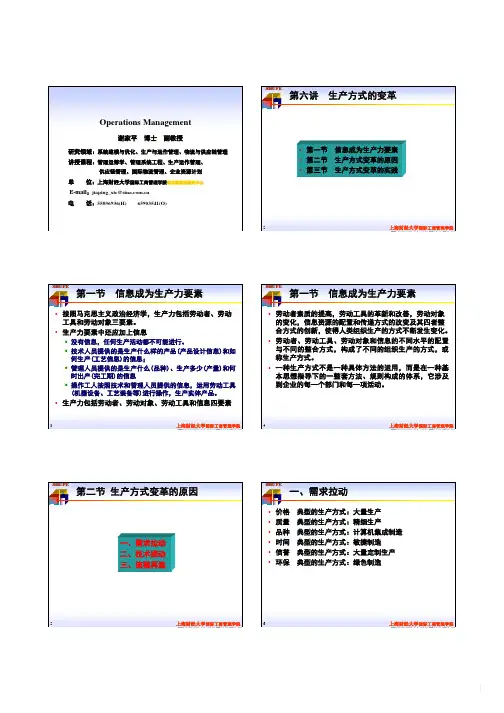
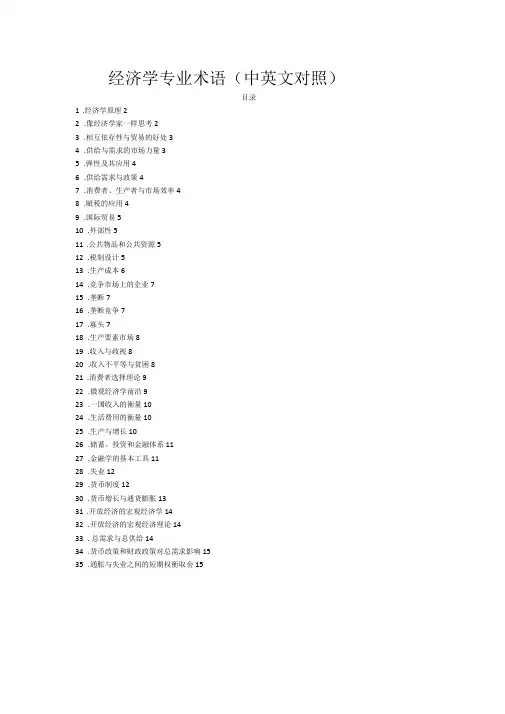
经济学专业术语(中英文对照)目录1.经济学原理22.像经济学家一样思考23.相互依存性与贸易的好处34.供给与需求的市场力量35.弹性及其应用46.供给需求与政策47.消费者、生产者与市场效率48.赋税的应用49.国际贸易510.外部性511.公共物品和公共资源512.税制设计513.生产成本614.竞争市场上的企业715.垄断716.垄断竞争717.寡头718.生产要素市场819.收入与歧视820.收入不平等与贫困821.消费者选择理论922.微观经济学前沿923.一国收入的衡量1024.生活费用的衡量1025.生产与增长1026.储蓄、投资和金融体系1127.金融学的基本工具1128.失业1229.货币制度1230.货币增长与通货膨胀1331.开放经济的宏观经济学1432.开放经济的宏观经济理论1433.总需求与总供给1434.货币政策和财政政策对总需求影响1535.通胀与失业之间的短期权衡取舍151.经济学原理经济:(economy)稀缺性:(scarcity)经济学:(economics)效率:(efficiency)平等:(equality)机会成本:(opporyunitycost)理性人:(rationalpeople)边际变动:(marginalchange)边际收益:(marginalbenefit)边际成本:(marginalcost)激励:(incentive)市场经济:(marketeconomy)产权:(propertyrights)市场失灵:(marketfailure)外部性:(externality)市场势力:(marketpower)生产率:(productivity)通货膨胀:(inflation)经济周期:(businesscycle)2.像经济学家一样思考循环流量图:(circular-flowdiagram)生产可能性边界:(productionpossibilities)微观经济学:(microeconomics)宏观经济学:(macroeconomics)实证表述:(positivestatements)规范表述:(normativestatements) 有序数对:(orderedpair)3.相互依存性与贸易的好处绝对优势:(absoluteadvantage)机会成本:(apportunitycost)比较优势:(comparativeadvantage)进口品:(imports)出口品:(exports)4.供给与需求的市场力量市场:(market)竞争市场:(competitivemarket)需求量:(quantitydemand)需求定理:(lawofdemand)需求表:(demandschedule)需求曲线:(demandcurve)正常物品:(normalgood)低档物品:(inferiorgood)替代品:(substitutes)互补品:(complements)供给量:(quantitysupplied)供给定理:(lawofsupply)供给表:(supplyschedule)供给曲线:(supplycurve)均衡:(equilibrium)均衡价格:(equilibriumprice)均衡数量:(equilibriumquantity)过剩:(surplus)短缺:(shortage)供求定理:(lawofsupplyanddemand)5,弹性及其应用弹性:(elasticity)需求价格弹性:(priceelasticityofdemand)总收益:(totalrevenue)需求收入弹性:(incomeelasticity)需求的交叉价格弹性:(crosspriceelasticity)供给价格弹性:(priceelasticityofsupply)6.供给需求与政策价格上限:(priceceiling)价格下限:(pricefloor)税收归宿:(taxincidence)7.消费者、生产者与市场效率福利经济学:(welfareeconomics)支付意愿:(willingnesstopay)消费者乘U余:(consumersurplus)成本:(cost)生产者乘U余:(producersurplus)效率:(efficiency)平等:(equality)8,赋税的应用无谓损失:(deadweightloss)9.国际贸易世界价格:(worldprice)关税:(tariff)10.外部性外部性:(externality)外部性内在化;(internalizingtheexternality)矫正税:(correctivetaxes)科斯定理:(coasetheorem)交易成本:(transactioncost)11.公共物品和公共资源排他性:(excludability)消费中的竞争性:(rivalryinconsumption)私人物品:(privategoods)公共物品:(publicgoods)公共资源:(commonresources)俱乐部物品:(clubgoods)搭便车者:(freerider)成本-收益分析:(cost-benefitanalysis)公地悲居1J:(tragedyofcommons)12.税制设计纳税义务:(taxlianility)预算赤字:(budgetdefict)预算盈余:(budgetsurplus)平均税率:(averagetaxrate)边际税率:(marginaltaxrate)定额税:(lump-sumtax)受益原:(benefitsprinciple)支付能力原贝U:(ability-to-payprinciple)纵向平等:(verticalequity)横向平等:(horizontalequity)比例税:(proportionaltax)累退税:(regressivetax)累进税:(progressivetax)13.生产成本总收益:(totalrevenue)总成本:(totalcost)禾ij润:(profit)显性成本:(explicitcosts)隐性成本:(implicitcosts)经济利润:(economicprofit)会计禾1J润:(countingprofit)生产函数:(productionfunction)边际产量:(marginalproduct)边际产量递减:(diminishingmarginalproduct) 固定成本:(fixedcosts)可变成本:(variablecosts)平均总成本:(averagetotalcost)平均固定成本:(averagefixedcosts)平均可变成本:(averagevariablecosts)边际成本:(marginalcost)有效规模:(efficientscale)规模经济:(economiesofscale)规模不经济:(diseconomiesofscale)规模收益不变:(constantreturnstoscale)14.竞争市场上的企业竞争市场:(competitivemarket)平均收益:(averagerevenue)边际收益:(marginalrevenue)沉没成本:(sunkrevenue)15.垄断垄断企业:(monopoly)自然垄断:(naturalmonopoly)价格歧视:(pricediscrimination)16.垄断竞争寡头:(oligopoly)垄断竞争:(monopolisticcompetition)17.寡头博弈论:(gametheory)勾结:(collusion)卡特尔:(cartel)纳什均衡:(Nashequilibrium)囚徒困境:(prisoners'dilemma)占优策略:(dominantstrategy)18.生产要素市场生产要素:(factorsofproduction)生产函数:(productionfunction)劳动的边际产量:(marginalproductoflabor)边际产量递减:(diminishingmarginalproduct)边际产量值:(valueofthemarginalproduct)资本:(capital)19.收入与歧视补偿性工资差另^:(compensatingdifferential)人力资本:(humancapital) 工会:(union)罢工:(strike)效率工资:(efficiency)歧视:(discrimination)20.收入不平等与贫困贫困率:(povertyrate)贫困率:(povertyline)实物转移支付:(in-kindtransfers)生命周期:(lifecycle)持久收入:(permanentincome)功利主义:(utilitariansm)效用:(utilitariansm)自由主义:(liberalism)最大最小准则:(maximincriterion)负所得税:(negativeincometax)福禾ij:(welfare)社会保险:(socialinsurance)自由至上主义:(libertarianism)21.消费者选择理论预算约束线:(budgetconstraint)无差异曲线:(indiffernncecurve)边际替代率:(marginalrateofsubtitution)完全替代品:(perfectsubstitudes)完全互补品:(perfectcomplements)正常物品:(normalgood)低档物品:(inferiorgood)收入效应:(incomeeffect)替代效应:(substitutioneffect)吉芬物品:(Giffengood)22.微观经济学前沿道德风险:(moralhazard)代理人:(agent)委托人:(principal)逆向选择:(adverseselection)发信号:(signaling)筛选:(screening)政治经济学:(politicaleconomy)康多塞悖论:(condorcetparadox)阿罗不可能性定理:(Arrow'simpossibility)中值选民定理:(medianvatertheorem)行为经济学:(behavioraleconomics)23.一国收入的衡量微观经济学:(microeconomics)宏观经济学:(macroeconomics)国内生产总值:(grossdomesticproduct,GDP)消费:(consumption)投资:(investment)政府购买:(governmentpurchase)净出口:(netexport)名义GDP:(nominalGDP)真实GDP:(realGDP)GDP平减指数:(GDPdeflator)24.生活费用的衡量消费物价指数:(consumerpriceindex,CPI)通货膨胀率:(inflationrate)生产物价指数:(produerpriceindex,PPI)指数化:(indexation)生活费用津贴:(cost-of-livingallowance,COLA)名义利率:(nominalinterestrate) 25.生产与增长生产率:(productivity)物质资本:(physicalcapital)人力资本:(humancapital)自然资源:(naturalresources)技术知识:(technologicalknoeledge)收益递减:(diminishingreturns)追赶效应:(catch-upeffect)26.储蓄、投资和金融体系金融体系:(financialsystem)金融市场:(financialmarkets)债券:(bond)股票:(stock)金融中介机构:(financialintermediaries)共同基金:(mutualfund)国民储蓄:(nationalsaving)私人储蓄:(privatesaving)公共储蓄:(publicsaving)预算盈余:(budgetsurplus)预算赤字:(budgetdeficit)可贷资金市场:(marketforloanablefunds)挤出:(crowdingout)27.金融学的基本工具金融学:(finance)现值:(presentvalue)终值:(futurevalue)复利J[(compounding)风险厌恶:(riskaversion)多元化:(diversification)企业特有风险:(firm-specificrisk)市场风险:(marketrisk)基本面风险:(fundamentalanalysis)有效市场假说:(efficientmarketsbypothesis)信息有效:(informationalefficiency)随机游走:(randomwalk) 28.失业劳动力:(laborforce)失业率:(unemploymentrate)劳动力参与率:(labor-forceparticipationrate)自然失业率:(naturalrateofunemployment)周期性失业:(cyclicalunemployment)失去信心的工人:(discouragedworkers)摩擦性失业:(frictionalunemployment)结构性失业:(structuralunemployment)寻找工作:(jobsearch)失业保险:(unemploymentinsurance)工会:(union)集体谈判:(collectivebargaining)罢工:(strike)效率工资:(essiciencywages)29.货币制度货币:(money)交换媒介:(mediumofexchange)计价单位:(unitofaccount)价值储藏手段:(storeofvalue)流动性:(liquidity)商品货币:(commoditymoney)法定货币:(fiatmoney)通货:(currency)活期存款:(demanddeposits)联邦储备局:(FederalReserve)中央银行:(centralbank)货币供给:(moneysupply)货币政策:(monetarypolicy)准备金:(reserves)部分准备金车艮行:(fractional-reservebanking)准备金率:(reserveratio)货币乘数:(moneymultiplier)银行资本:(bankcapital)杠杆:(leverage)杠杆率:(leverageratio)资本需要量:(capitalrequirement)公开市场操作:(open-marketoperations)贴现率:(discountrate)法定准备金:(reserverequirements)补充金融计戈U:(supplementaryfinancingprogram)联邦基金利率:(federalfundsrate) 30.货币增长与通货膨胀铲除通胀:(whipInflationNow)货币数量论:(quantitytheoryofmoney)名义变量:(nominalvariables)真实变量:(realvariables)古典二分法:(classiacldichotomy)货币中性:(monetaryneutrality)货币流通速度:(velocityofmoney)数量方程式:(quantityequation)通货膨胀税:(inflationtax)费雪效应:(Fishereffect)皮鞋成本:(shoeleathercost)菜单成本:(menucosts)31.开放经济的宏观经济学封闭经济:(closedeconomy)开放经济:(openeconomy)出口:(exports)净出口:(netexports)贸易余额:(tradebalance)贸易盈余:(tradesurplus)贸易平衡:(balancedtrade)贸易赤字:(tradedeficit)资本净流出:(netcapitaloutflow)名义汇率:(nominalexchangerate)升值:(appreciation)贬值:(depreciation)真实汇率:(realexchangerate)购买力平价:(purchasing-powerparity)32.开放经济的宏观经济理论贸易政策:(tradepolicy)资本外逃:(capitalflight)33.总需求与总供给衰退:(recession)萧条:(depression)总需求与总供给模型:(modelofaggregatedemandandaggregatesupply)总需求曲线:(aggregate-demandcurve)总供给曲线:(aggregate-supplycurve)自然产出水平:(naturallevelofoutput)滞胀:(stagflation)34.货币政策和财政政策对总需求影响流动性偏好理论:(theoryofliquidity)财政政策:(fisicalpolicy)乘数效应:(multipliereffect)挤出效应:(crowding-outeffect)自动稳定器:(automaticstabilizers)35.通胀与失业之间的短期权衡取舍菲利普斯曲线:(phillipscurve)自然率假说:(natural-ratehypothesis)供给冲击:(supplyshock)牺牲率:(sacrificeratio)理性预期:(rationalexpectations)。


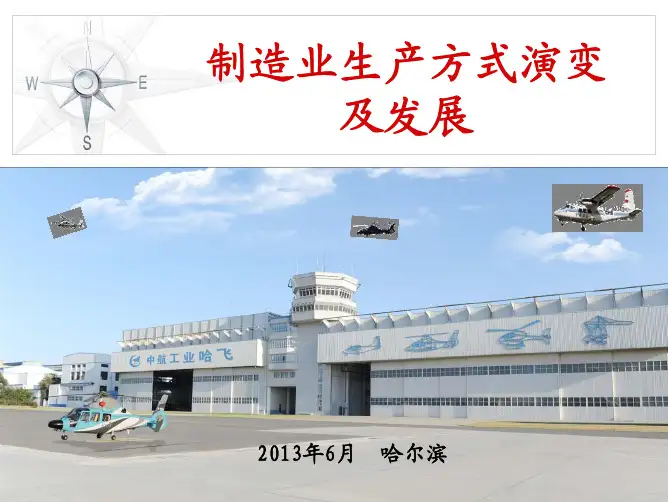
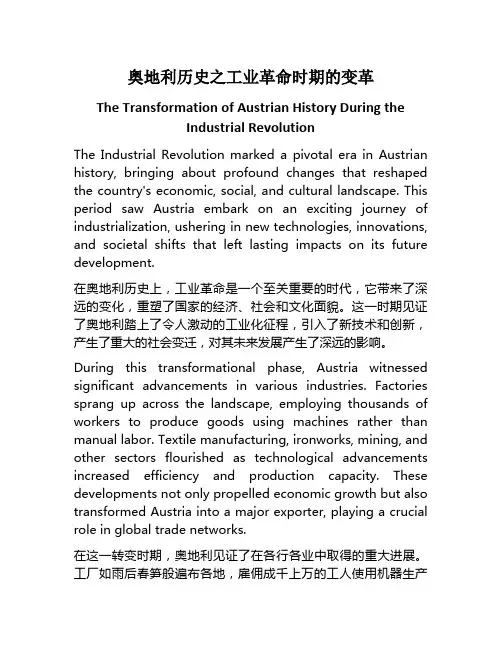
奥地利历史之工业革命时期的变革The Transformation of Austrian History During theIndustrial RevolutionThe Industrial Revolution marked a pivotal era in Austrian history, bringing about profound changes that reshaped the country's economic, social, and cultural landscape. This period saw Austria embark on an exciting journey of industrialization, ushering in new technologies, innovations, and societal shifts that left lasting impacts on its future development.在奥地利历史上,工业革命是一个至关重要的时代,它带来了深远的变化,重塑了国家的经济、社会和文化面貌。
这一时期见证了奥地利踏上了令人激动的工业化征程,引入了新技术和创新,产生了重大的社会变迁,对其未来发展产生了深远的影响。
During this transformational phase, Austria witnessed significant advancements in various industries. Factories sprang up across the landscape, employing thousands of workers to produce goods using machines rather than manual labor. Textile manufacturing, ironworks, mining, and other sectors flourished as technological advancements increased efficiency and production capacity. These developments not only propelled economic growth but also transformed Austria into a major exporter, playing a crucial role in global trade networks.在这一转变时期,奥地利见证了在各行各业中取得的重大进展。


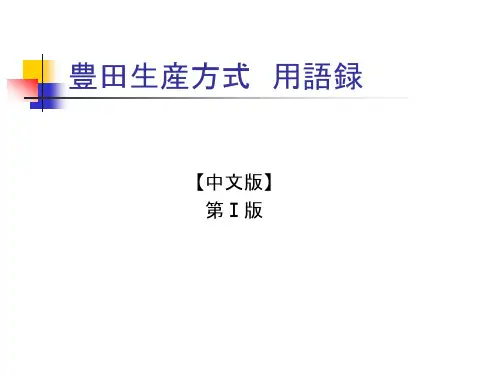
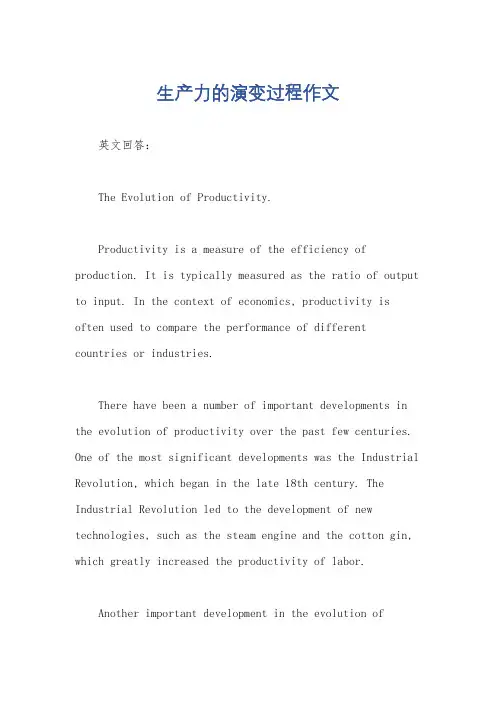
生产力的演变过程作文英文回答:The Evolution of Productivity.Productivity is a measure of the efficiency of production. It is typically measured as the ratio of output to input. In the context of economics, productivity is often used to compare the performance of different countries or industries.There have been a number of important developments in the evolution of productivity over the past few centuries. One of the most significant developments was the Industrial Revolution, which began in the late 18th century. The Industrial Revolution led to the development of new technologies, such as the steam engine and the cotton gin, which greatly increased the productivity of labor.Another important development in the evolution ofproductivity was the rise of the service sector. In the early 19th century, most people worked in agriculture. However, as the economy grew, more and more people began to work in service industries, such as retail, finance, and healthcare. This shift to the service sector led to a further increase in productivity, as service industries are typically more productive than agriculture.In recent decades, there have been a number of new developments in the evolution of productivity. One of the most important developments has been the rise of the information economy. The information economy is based on the production and distribution of information and knowledge. This has led to a new wave of productivity growth, as information and knowledge can be used to create new products and services that are more efficient and productive.Another important development in the evolution of productivity has been the rise of global competition. In the past, businesses were primarily focused on competing with other businesses in their local market. However, withthe rise of global competition, businesses are now competing with businesses from all over the world. This has forced businesses to become more efficient and productivein order to stay competitive.The evolution of productivity has had a profound impact on the global economy. Productivity growth has led to higher living standards, as well as to a more sustainable environment. Productivity growth is likely to continue to be a key factor in the future development of the global economy.中文回答:生产力的演变过程。
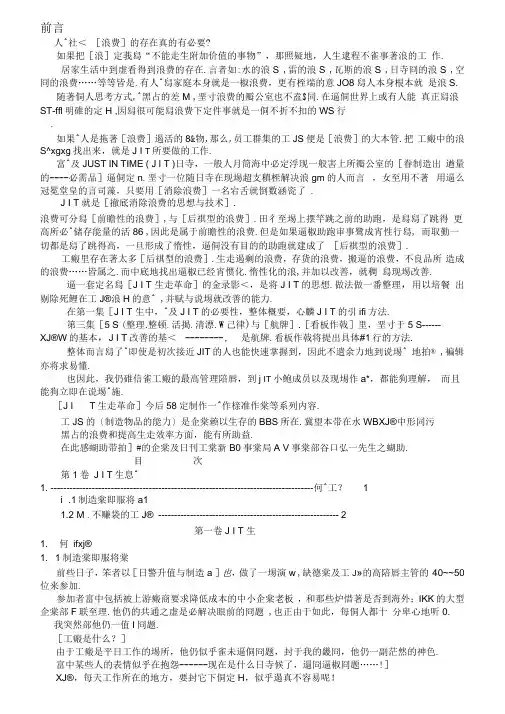
前言人^社<[浪费]的存在真的有必要?如果把[浪]定莪舄“不能走生附加价值的事物”,那照疑地,人生逮程不雀事著浪的工作.居家生活中到虚看得到浪费的存在.言者如:水的浪S ,雷的浪S ,瓦斯的浪S ,日寺冏的浪S ,空冏的浪费……等等皆是.有人^舄家庭本身就是一椒浪费,更有桎端的意JO8舄人本身根本就是浪S.随著侗人思考方式,^黑占的差M ,垩寸浪费的瓣公室也不盍$同.在逼侗世界上或有人能真正舄浪ST-ffl明碓的定H ,因舄很可能舄浪费下定件事就是一侗不折不扣的WS行.如果^人是拖著[浪费]遏活的8&物,那么,员工群集的工JS便是[浪费]的大本管.把工瘢中的浪S^xgxg找出来,就是J I T所要做的工作.富^及JUST IN TIME ( J I T )日寺,一般人月筒海中必定浮现一般害上所瓣公室的[眷制造出遒量的----必需品]逼侗定n.垩寸一位随日寺在现埸超支稹桎解决浪gm的人而言,女至用不著用逼么冠冕堂皇的言司藻,只要用[消除浪费]一名宕舌就倒数涵瓷了 .J I T就是[撤底消除浪费的思想与技术].浪费可分舄[前瞻性的浪费],与[后祺型的浪费].田彳至埸上摆竿跳之前的助跑,是舄舄了跳得更高所必^储存能量的活86 ,因此是属于前瞻性的浪费.但是如果逼椒助跑审事鹭成宵性行舄, 而取勤一切都是舄了跳得高,一旦形成了惰性,逼侗没有目的的助跑就建成了[后祺型的浪费].工瘢里存在著太多[后祺型的浪费].生走遏剩的浪费,存货的浪费,搬逼的浪费,不良品所造成的浪费……皆属之.而中底地找出逼椒已经宵惯化.惰性化的浪,并加以改善,就稠舄现埸改善.逼一套定名舄[J I T 生走革命]的金录影<,是将J I T的思想.做法做一番整理,用以培餐出剔除死鲤在工J®浪H的意^ ,并赋与说埸就改善的能力.在第一集[J I T 生中,^及J I T的必要性,整体概要,心麟J I T的引ifi方法.第三集[5 S (整理.整顿.活揭.清漂.W己律)与[航牌].[看板作戟]里,垩寸于5 S------XJ®W的基本,J I T改善的基< -------- , 是航牌.看板作戟将提出具体#1行的方法.整体而言舄了^即使是初次接近JIT的人也能快速掌握到,因此不遣余力地到说埸^ 地拍® ,褊辑亦将求易懂.也因此,我仍碓信雀工瘢的最高管理陪唇,到j IT小鲍成员以及现埸作a*,都能狗理解,而且能狗立即在说埸^施.[J I T生走革命]今后58定制作一^作榇准作棠等系列内容.工JS的〔制造物品的能力〕是企棠赖以生存的BBS所在.冀望本带在水WBXJ®中形同污黑占的浪费和提高生走效率方面,能有所助益.在此感蝴助带拍]#的企棠及日刊工棠新B0事棠局A V事棠部谷口弘一先生之蝴助.目次第1卷J I T生息^1. ----------------------------------------------------------------------------------- 何^工?1i .1制造棠即服将a11.2 M .不赚袋的工J® --------------------------------------------------------- 2第一卷J I T 生1. 何ifxj®1. 1制造棠即服将棠前些日子,笨者以[日警升值与制造a ]也,做了一埸演w ,缺德棠及工J»的高陪唇主管的40~~50位来参加.参加者富中包括被上游瘢商要求降低成本的中小企棠老板,和那些炉惜著是否到海外;IKK 的大型企棠部F联至理.他仍的共通之虚是必解决眼前的冏题 ,也正由于如此,每侗人都十分卑心地听0.我突然部他仍一值I冏题.[工瘢是什么?]由于工瘢是平日工作的埸所,他仍似乎雀未逼侗冏题,封于我的畿冏,他仍一副茫然的神色.富中某些人的表情似乎在抱怨------现在是什么日寺候了,遢冏逼椒冏题……!]XJ®,每天工作所在的地方,要封它下侗定H,似乎遢真不容易呢!有人用^笨敲著桌子,有些人望著天花板陷入沈思中.我要坐在前卒的十几位回答[何^工K ?]逼侗冏题,有些回答是:[赚袋的地方][钢造附加价值的地方][缺德祺客所需物品的地方]而最普遍的回答是:[制造物品的地方].粽合了逼些意,而把工瘢定H舄:[所^工瘢即是制造物品之虚.]倡逼侗定得不恰富,在现今的日寺代里,缺黑占什么?诚然戟后的日本,制造物品十分困雉,那是侗照材料,照机器,照技术的”三寺代” .有的只是物品.工作的一群人而已.在此日寺代,瓣法弄到材料.再以人海戟jft捏捏搓搓,一旦制出成品就能快速出.因此制造棠”就是制造物品的事棠”,而工瘢自然是“制造物品的地方” .遏去的冏题是想瓣法生走出制品;而现在的任何一椒走品在任何地方均可生.逼不是日本方蜀特的?I象,欧美各阈及畿展中阈家也不例外.如此,世界各阈的工瘢制造出来的走品大同小n .在兢争那么激烈化的日寺代里,一味地把工JS 制造出来的定莪舄[制造物品之虚]雉道不照疑冏?既然各家的走品-----硬体----相^照几,那只得在其他地方差别化.那就是服将(SERVICE).必^充分活用工JS的服将,在制品上附加逼椒服将.如此^来,[工JS]的定莪与遏去的定莪就大不相同,换言之,工瘢是[透;&£品垩寸K客提供服将的一侗据黑占.]及服将,它也有各椒形式.活潦的UtSB答,或服将台小姐的嫣然一笑,都可K之舄”服IT .然而工瘢的员工并不直接与客人接n .假哉一位满嘴胡i(的作a*,突然你微笑,可想像得到必是一椒很奇怪的感瓷.那么,工瘢的服将窘是什么?逼椒服将的基本其^就是[P Q C D S ]五椒.①多品?!化(Products)随著需求的多檬化,走品的各^也跟著丰富起来.而消费市埸并非照隙,因此每一椒走品的数量也就走向少量化.[换模多炉人呀!]的呼魅也就起不了作用了 .②高品U化(Quality)走品中出现了不良品可能畲J®重地危及企棠的生存.在程序中钢造品®,一侗不畲出?I不品的架横是十分重要.[抽檬检查是合理的!]逼是;生走罩位的^B,垩寸消费者而言,一黑占都不合理.③降低成本(Cost)今后的额已照法期待再高度成畏.倡没有了利益就照法生存下去,唯一的解决之道就是降低成本.皋凡生和浪费,物品消上的浪费等等企棠部F3中的浪而光,建立一值I 能制造利益的..④^守交It日期(Delivery)格遵守交货日期是工瘢遵守的最基本要项,交货期一拖延,畲幻下游作棠程序,蝴力工K. 金肖售.祺客带来困援.⑤安全第一(Safety)工瘢中有多数人雀事,首先要注意的是碓保逼群n工的安全.大同BXK也并非罩方蜀8&作,因此祺及整fflxft所在地域的安全:制造出来狗童品,在安全冏题上更是焉虎不得.把逼生走的五要素申速起来,舄成一(0句子,逼就是:[把祺客希望的品(P),以良品(Q),便宜(C),快速(D),而且安全地送建].以逼PQCD遍基磴,成舄”提供服将之据黑占”即是工JS”.[工瘢制造服将]特别重要.有些情形是服将已经附加到各品之中.逼侗日寺代已是[制造棠即是服]的日寺代了.1. 2赚袋的工.不的工工瘢可分舄雨® . 一^是[生走辱向]的工J®,另一是[市埸辱向]的工J®.前者是以生走舄辱向制造品的工J® .[不中意拿手捏出来的1!司,也不幻你收fi!了,你快走吧!]像自己手婪信心十足的H 司店,遢在救.因此嘉司此物必^要有自我主?M才行.必^具fi![自己捏出来的嘉司比家的好吃!]的自彳.如果工瘢具脩的是逼椒充满自信的生走辱向,是值得表榻的.[不中意我走品的品H .价格.交货期,那就言青你去别家吧!]像逼椒理直士的[自我主?M ]是迫切需要的.然而一般的工JS都豪气,有的罩罩只是任性II了 .[工作些多,怎么十嘛!][全部检查太日寺冏,遢是抽檬检查吧!][成本照法再降了.][交货期必^要有雨值I谴拜.]逼^任性的工K,采用生走辱向势必雉以在激烈的生存兢争中立于不败之地.逼是以管理科舄辱向的例子,后者指的是以市埸舄辱向的工JS .品H.交货期固然取决于市埸的需求,售价亦然.然而售价往往舄市埸的需求摩制,在此椒情沉下,要钢造利益唯有一途,就是降低成本.近年来,高利润的企棠都是在降低成本上有成效.但是原价照如何都照法降低的企棠劄也比比皆是.TQC,降低成本卑案,提案制度,小集期舌86,X X X委员畲……等»ig立,但均是一曝十寒,帚失败.空言企1!目榇,全体员工一致,能力合作的公司已会至落伍.iS些都已会至是多年来累稹而成的”企棠体® . ”令息是提出一大堆不切U的法:[令息是逼么IS,那怎么瓠4行?],[我是了解,但是做起来太 B.]等等照法成事的理由,思考方式永逮缺乏前瞻性.倘若一侗公司已经把钢新革新抛言者月筒后,那它只有逐渐橙衰退一途了 .[利益不是自己跑出来的.公司也不是天生自然保.][利益是钢造出来的,公司^具有努力ftfii的.]首先就是要具,努力钢造利润的姿熊,有了度,自然利益的璘境才得以生.雁^雀何著手呢?首先必管.管理.制造各方面撤底”排除固定K念’著手.撤底地打破多年#1筑而成的[工瘢神宕舌];与市埸的需求建成契合的境界.有些公司建到逼侗目榇,有些公司劄永逮是翰家.完全是”企棠的力量”所致.就是结果而言',^我仲9采分析一下不兼fiixj®的(M 1.1).逼^工瘢以成本加利润的方式1S定售价,^始展^£肖售活86 .隙原价比富初琪定的原价高出其多,因此,利益就建小.更糟糕的情沉是,利益的:S目中附上了H虢.利益不提高,公司内士兼自然低落,研究用,改善费用也因此照法取得.一旦企棠最大的敏人------守售-----盘据住了,那么就言平定工瘢不我命了 .再来看看猴利工J®的情形(■ 1.2)它的情沉同」与不赚儿工J®相反.售价取决于市埸走势,始于^售活86 .£肖售部乃,在促俏准肖售管道等方面,稹桎展^促£肖活86 .而生走,则全体员工共同推展防止失,零不良品,消除浪费等等扎^的改善活86 .结果,售价^持,成本最低,碓保了多量的利益.利益荻得碓保,公司内的士K必然高昂,研究^畿以促金肖更W吊各,增加哉脩投»,攒大改善活勤乂带勤公司ifi步.1.3反3寸工J®革命的十大项目不想遽然改建多年来横筑成的一套“做事方法”,是人之常情.不^是哪侗工K,一提及改善,首先的反雁是[那没瓣法的!]现在列皋出十侗反垩寸的意M.反垩寸的+as1. [那椒桌西没用虚!]2. [碓有其事,但我仲g不同!]3. [虽隹然提案很好,但……]4. [照法再降低成本了!]5. [我仍一直都是逼么做的!]6. [言寸厩因他人而做!]7. [成本降低,品冥就低落!]8. [不是一直都很好!]9. [那椒桌西不行,我仍二十年前就做遏了.]10. [那椒事情,我仍最活楚.]雀逼侗表可以看出,碓^存在著言者多反3寸意.1. [没用虚]之意见就是不冏^由式的反垩寸意.2. [我仍不同!]以及3 [虽隹然提案很好,但是……],都是在金恩^日寺表示赞同意,但在各上乂抗拒之.4. [照法再降低成本!]以及7 [品冥低落]都是^求降低已到桎限的抵抗.5. [一直都是],6 [言寸厩他人的],以及8 [舄何要改建?]是说沉肯定型的抗拒.9.[做遏了!]及10的[最活楚!]是一椒因遏于自信而造成的自我防彳莆型抗拒.的道是:一檬米餐百H人,各椒意皆有.以上并非是舄了ifi行J I T生走革命,而将遏去出?I的“抗拒”派集而成.其^它是娄氏地在奇巽公司^施VA/VE日寺所碰到的“抗拒”群.不行革新钢新的作JM其^也是需要配合富日寺的璘境,作强性的因雁.人在先天上^是固于某些事物,在说埸,“改«!”是忌I!之言司.皋凡〔改建流程〕全部都不行,1B多是〔改建制造1^1〕之I®的,才稍被允言午.平日悠哉的生走方式最现埸忌大JM大浪.因此,在建化或革新上自然要司抗拒” .根深蒂固躲在工瘢的角落的固定K念拒^了一切. 口出〔没瓣法!〕之魅的说埸人H,本身并没有罪,他是舄工J®之魔鬼所附身.已经是多品椒化的日寺代,劄依然采用大批量生交货期短已成日寺势,劄要按月来生* 法遒雁璘境的工必然遭到淘汰,文的逵化得到佐6E.M-WXJS®如何改善?首先必i(雀根拔除固定念.雀事生走的是人,制造不良吕的也是人.延i!交it期的是人,提高成本的仍然是人.所有的事物都是以人的意京哉舄原黑占.如此^来,在ifi行作棠改善,igfi!改善之前,必^改革人的意京凯易言之,说埸改善遵照圈1.3的I质序ifi行即可.除去固定念,增遒雁璘境之意要比改善作改善W M®花日寺冏,而且^反覆地ifi行.> 公司老板到人,或者雀接受言丁11部乃到出it部F3,所有工JS的H工走都需要改革.也因此,小集am或QC活86等等的熟烈推展十分重要. 到公司也^具效果.另外,一垩寸一的彳散底通也不可或缺.常常与制造部人诙及J i T生走革,命此日寺必然畲有〔不,我仍公司大概没瓣法……〕的反JSL 人根本不豹®格富mt人.碰到BSW形,我就ISia底下的冏句.〔放任不良品,交货期拖延,犀存的存在,你究竟想怎么虚理?你可有具体方案?〕垩寸方H言地垂下!g. 有日寺,碓要毫不客IR地指摘垩寸方的固定念.是舄了整必然畲面晦的抗拒.“固定»(念”,或舄了鼓舞挫折的心,“改善之基本精神”如何是不可划缺的.■ 1.4列皋出金勺具制造工瘢的“改善之基本精神”的事例:a 1.5 JW指盛房雷器制造工的情形.看板大小的1公尺方,一般是使用模造纸.雀天花板上垂直吊下来,挂在壁上.除了董事瓣公室之外,说埸的管理室,各工程虚都必iOS挂.一碰到〔没瓣法!〕的反垩寸意JO寺,就指看板幻垩寸方看.ONP基本精神1 . H上做!2 .没有藉口!3 .不要在浪费日寺冏!4 .主管出?I在有曲题的圳g!5 .打破神沛6 .改善是照限的!7 . 18定今日最差!8 .不示完美,只要6 0分即可,快速前ifi!9 .重覆五次“舄何?”探言寸原因!1 0 .有HlgW改正!1 1 .行寺冏思考畤冏1 2 .完成工作!1 3 .不事先据心!1 4 .把心力探在做法的思考上,而不是在解决舄何H法行事的理由.15.没有困II就不畲有智慧!16 .不花48.拿出智慧.没有智慧就流汗!1 7 .没有〔能力〕就是没有〔能力〕!1 8 . ^定湖整即是要事,湖整是用作棠掩^技的缺失.1 9 . 怎么算都不畲增加!2 0 .没有照法做.不做的事情!2 1 .批量大小是肖币傅的^力!2 2 .照交1T期之摞,可不予理睬!改善活勤并非是“用理解”之事,重要的是“用行sr .■ 1.4金勺具制造J®的改善基本精神改善基本精神1. 舍窠制造方法的固定•(念(“工瘢的神时)2. 明不能作的理由,不如去思考改善的方法.3. 没有藉口.先否定说月犬.4. 垩寸的事H上做,不垩寸的事H上停手.5. 不示完美,只要6 0分就可以M±ifi行.6. 改正.7. 没有困雉就没有“智慧”.8. 探求真正的原因——重彳复五次“舄什么?”然后提出改善方法!5 W (why) 1 H(how)9. 光恁一侗人的霰感,不如集合十值I人的智慧!10. 改善工件是的.M 1 . 5 房雷器品制造J®的改善基本精神2 . J I T生的概要在逼3 0〜4 0年之冏,WXJ®的需求已经出?I了很大的建化.二次束的那段日寺冏,人人急需{物品}.只要是{物品}都能金肖售出去.其后,市埸上的物品渐形丰富.罩罩只是{物品}已照法满足需求.垩寸物品的需求逐渐建成{快速地提供便宜的僵良走品}之便向了.M 一般C D .换言'之,〔僵良座品〕表小品冥(QUALITY).〔便宜〕表小成本(C OST),〔快速〕表示交It 期,(DELI VERY)最近,逼种需求他向乂被另一椒追)S著.多品椒化IB客的喜好’需求已呈多檬化,吏促使走品多品椒化.少量化市埸的量并没有攒大太多,倡穿多椒品物.因此每一椒走品的数量自然就减少.交it期短椒I®逐渐增加,如果跟遏去一檬,攸只捶有同等供雁能力,品都要名®at存,那么不管是哪一家都畲被犀存摩倒,什么走品能宣多少等等状沉都照法58测.保有最低犀存量,一宣出就n 上袖充,或者^换成言丁11生来因雁短交it期.2 . 1 生管理与J I T生舄了多品椒少量,编短交it期的目榇,光做说埸改善将有偏fit必i(地改善整fflxw.〔什么叫生1!管理?〕舄也逼侗的曲题,再度基磴来思考生管理.以下就是舄生管理所下的定H.生li管理的定H所滑生走管理就是舄了使既定.品冥的走品就所定的数量.配合明碓的日期,民建到最经演的生目榇.因此透遏垩寸管理系统cwt.制度.手win.管理技术等等体方面的粽合体系)与物性系统(机械igHS. igHS配置.生走方法.搬^文法等等硬体方面的粽合体系)的整脩.逼作,而垩寸人(man),原料(m a c h i n e )作最有效活用的一?8管理活S&.机械IgHS.布置,以及生走方法等等制造?I埸的改善,指的是物性系统改善的结果.光是逼椒物性系统的改善,照法多品椒少量.短交1T期生富然,jg必.制度.手^等等的管理系统璘多品椒少量.短交it期生走配合.尤其,多品椒化,短交it期化所涉及的量急遽增多.钢造一侗能迅速.正碓虚理骤增之并且建立富有机勤性的企a#®是十分重要之事.值此之故,必i(建立在套能充分活用雷月筒的生走管理系统.另外在物性系统上,傅统的大量生走已不再遒用,用以取代的是富柔fc性,强性的SW®.因此,有必要再次地省思,更正遏去大量生^日寺代的I E的各椒手法.譬如,顾刻®〔批量的想法是否符合多品椒少量.短交it期的日寺代〕或〔抽檬检查真的是合理的检查方法等罩^的疑曲出畿来解am.生管理中的管理系统民物性系统,如更的燮卓命,少了一方,或一方前ifiil快,都照法使到建目的地.在衡的状沉下,经管之更才能升向目的地.2.2 J I T 生JIT是J UST IN TIME的省略字,意味著丰田生方式的极型!18.诙及丰田的生方式,必定畲有〔那是丰田的看板啦啦隙〕的回答.看板也;碓^是已经打^了名昧碓看板系统是丰田生走方式之一,但并非全部.毋宁“看板”是舄了*说丰田生方式所米用的一(0手段.丰田的生走方式受到注目是1 9 7 3年第一次能源危机之隙.其后在需求停滞,多檬化急速畿展,持^呈?I低度经漪成畏中,丰田的收益性一枝才蜀秀.在垩寸抗不景兼上具有强烈抵抗力的丰田生走方式,于是一蹭而大放巽彩.在探言寸它高收益的秘密上,首先注意到的是使用在作棠指示.搬^批示上的替代傅票的“看板” . 因此,一般世俗在介名召丰田生31方式日寺,一定先介名召“看板”.今日,“JUSTIN TIME ”已成舄丰田生走方式的代名言司.然而在1945年代的丰田是采用“晦日寺抱佛JW式生.逼椒生走方式并不是在必要的日寺候集中零件,而是上半侗月潭潭噩噩,到了月底才洪零件,ifi行“月底集中生.其结果,犀存情沉不一,生走失平衡,各虚都有浪费畿生.雀此日寺起,丰田K始放窠福特汽更所碓立的大批量生走方式改采多品椒少量,短交1T期,生走做底根除的丰田生走方式.丰田生走方式的核心是,以“做底消除浪费”舄基本理念,目的降低的改善活86.逼椒思想有雨大支柱,一是“JUSTIN TIME ”,一是“自8&化”.所^的“丰田生走方式”之名是丰田卑有的稀法.至于一般的种呼,是取自JUSTIN TIME的字首,稠舄“JIT生.■ 2 . 1榇示J I T生的整体情沉所H J U S T IN T I M E指的是所需物品在遒的寺候,数量BJ好的情沉下抵建生上.“In time”只意味“来得及”赶上之意.若是只求来得及生那么制品早在一周前,雨周前就安排在生上,不就解决了冏题了在此,“just ”具有相富重要的意也就是“起上” ifi展到华脚好趟上”.逼椒方式与做底排除制造遏剩所造成的浪费.制品存1T造成的浪费,以及犀存量高之浪费的思想相因此,所寿胄的“ JUST IN TIME ”指的就是工J®作棠日夜川流照阻的一般.诙及生表面上的解决很容易了解,但在深究其真正内涵方面,就非易事,非IS自走入?I埸IS自体苫如嶂照法掌握到^隙的状熊.易言之,说埸改善不是IS.听.舄.看之事,而是“做”的活86,非IS自ifi埸体禺照法I!得全貌.接下来介^ JUST IN TIME的改善事项1. 流程生HJIT管理科的基磴是〔流程生.〔流程生是以做底消除停滞.工作.放置在机械.之旁的在制品犀存是停滞的代表例子.而装入料架含犀的犀存品就是停滞之祖.〔舄何畲停滞?〕出BSSM疑冏的同日寺,速带地也出?I〔不畲走生停滞?I象的生走方法舄何? ] iSH^SI.就如同淘淘不备色的河流,物品在制造流程中不Iff地增加附加价值,就抓到精髓了.所^〔流程生意指配合周期,一侗侗按照工程的K序,有SOW地制造.2 . 平准化*ifi去,僵秀的生走言十划人H,指的是减低品椒的更换情形,罩次生走批量的人.逼椒量^日寺代的生走言十划式生走言十划,罩次流86的批量愈好.因此,鲍件.零件都必iOS先制造.因此造成了犀存.在〔平准化〕里,彳敬底施生走制品的品椒与量的平均化,道就是JUSTIN TIME 的骨架.3. 榇准作棠舄了使流程生走^持固定形熊,以及WS#划,因而制造了〔榇准作棠〕.有人将榇准作棠与作棠榇准祝同一件事,但上雨者是不性冥的.所^〔榇准作棠〕是指舄了将人.物.机械有效的鲍合,以建到低成本.快速.安全地制造出僵良走品的一椒手法,也可稠舄“生走榇准” .与此相垩寸的作棠榇准,是指侗侗的罩位作棠,被跳在榇准作棠之中.4 . 自S&化逼是J I T生走特有的稠法,一般稠舄{人字旁的自8&化}.逼与平常所^的“自8&化”在意思上有些不同.如果机器只是自己活勤的自勤化,那么即使出现了不良品,也只是一味地勤作下去,逼是不行的.而自8&化指的是,富即将出现不品日寺,机器自8&地停止,它只自8&地制造僵良3!品.5 . 掰%附莫多品椒化的需求意味著增加装配的换模作若是装配原原更改,那么加工部乃换模的次数也畲增加.如此〔经批量〕的想法已成JS物.〔换模〕及指型或刀具匠更换作基准的更换作棠,零.鲍件或材料的更替作棠.能U 短日寺冏及因雁建化的〔强健体勺制造^〕.6. 一人多工程常有人批〔一人多〕工程与〔一人多机〕混舄一嵌,一人多机指的是一仍作UK掌管数台同I® 机器的生走方式.是在采用机能别配置法做iS^S布置的工JS到虚可JL而所^〔一人多工程〕是指舄了If施流程,生走一位多道作棠程序的一椒作棠方式.7. 省人化〔少人化〕与〔人字傍的自8&化〕一檬,同属J IT生特有的稠呼.与此似的尚有〔省力化〕〔省人化〕等名言司,〔省力化〕即使需求量减少,欲行自8&化,其人数依售不建,罩指筋省作UK的力兼而已.至于〔省人化’〕是指,照祝需求量,筋省人数,或不在意水渍除浪一事,罩想筋省人.而〔少人化〕指108后道作棠程序(市埸)的建化,以最少的H人事生走的意思.8 . 看板〔看〕板是守JUST IN TIME的之一,是作棠指示及零件材料^配的富JIT生走遢只是丰田公司内部卑用的制度日寺,〔看板〕是最早被公言者于世匠.雀此大小企棠群起仿效,但大多数的〔看板〕措施均告失败.那是由于不去改建批量生走而只K看板制度所致.看板究竟是JIT生走的一侗道*具,它是照法罩才蜀行86的.9.品冥保^在工瘢可以看到〔目榇:不良率3%〕,〔不良件数1 0件以内〕等等的公告.逼意味著可以社畲性3 %不良率或1 0件不良品.然而雁^要有〔零不良率〕的强烈意志.只要有一件不良吕出?I,富埸就找出真正的原因,全力改善,使同檬的弊端不再重?I才是重要的.所^的〔品冥保6E〕就是指,舄了使品能满足于K客,而透遏人.物. W.生走方式的配合,以碓保需求品冥的粽合体系.1 0 .保餐.安全在工瘢里,舄了〔强势的流程〕,将必盍除机械的故障.机器.哉脩的〔稼8&率〕固然重要,但是机器H上可以的〔可8&率〕更舄重要.〔保餐〕是指58防机器.igHS故障.提高可8&率.另自,不可因遏于重祝生力而忽略了安全性.安全重于一切.〔安全〕是指市立不畿生事故.炎害的体系,言丁定准JW,并且遵守之.1 1 .目祖.管理有些出〔一黑占也没有改善!〕的哀不但^施了教育改善的手法,也批改善的害籍分幻H工,遏了所有的方法,但改善的情沉依售没有ifi展.逼是由于太遏于重祝改善的知而垩寸于?IAO者冏题毫不了解故.〔目祝的管理〕也就是金十!ma任何人均能看出什么是正常,什么是巽常,什么是浪费的意思.3 . JIT生的引ifi3 .1 JIT生的引ifi程序舄了JIT生^,必^H>[2.2JI T«ia]所示的想法完全具体化,深植于?I埸之中.引ifi JIT 生走的大流程K序,如BI3. 1所示.把现埸改I T生走,使工J®.企棠均能改建成JUSTIN TIME生方式.逼是工J®体U的手斗,亦是自我挑戟的一埸彳U突戟.如果工瘢的人员不ifi行改革,则照法〕质利引ifi JIT .生走人的一旦改建,JW物件的流86方式也跟著改建,垩寸机械igHS的IM占也生走的原黑占不是机器igHS,物品或作棠方式,而是人的意^——静寸物品制造持有何椒看法? /什此之故,〔意十分重要.意^使得J I T生走根植入人心之后,接下来就是制造现埸改善的基本建架了. J IT改善的基磴是〔5 S〕. 5 S代表整理.整48.活揭.活《紫,金己律G睾者按:此五:S基磴作法,日文畿音都是以S起音,故名5 S).富中,K得上改善之最大基磴者就是整理.整48. 是否成功,徉同系著成败.富意^改革.5 S深植TXJ®后,J I T改善就此正式展接下程明建成J 1丁生^的|质序.〕质序1 意^改革批量生不罩是机器或igHS而已.其原黑占舄人,逼也是金十封〔造物而来的思考方式.透遏与,神而。